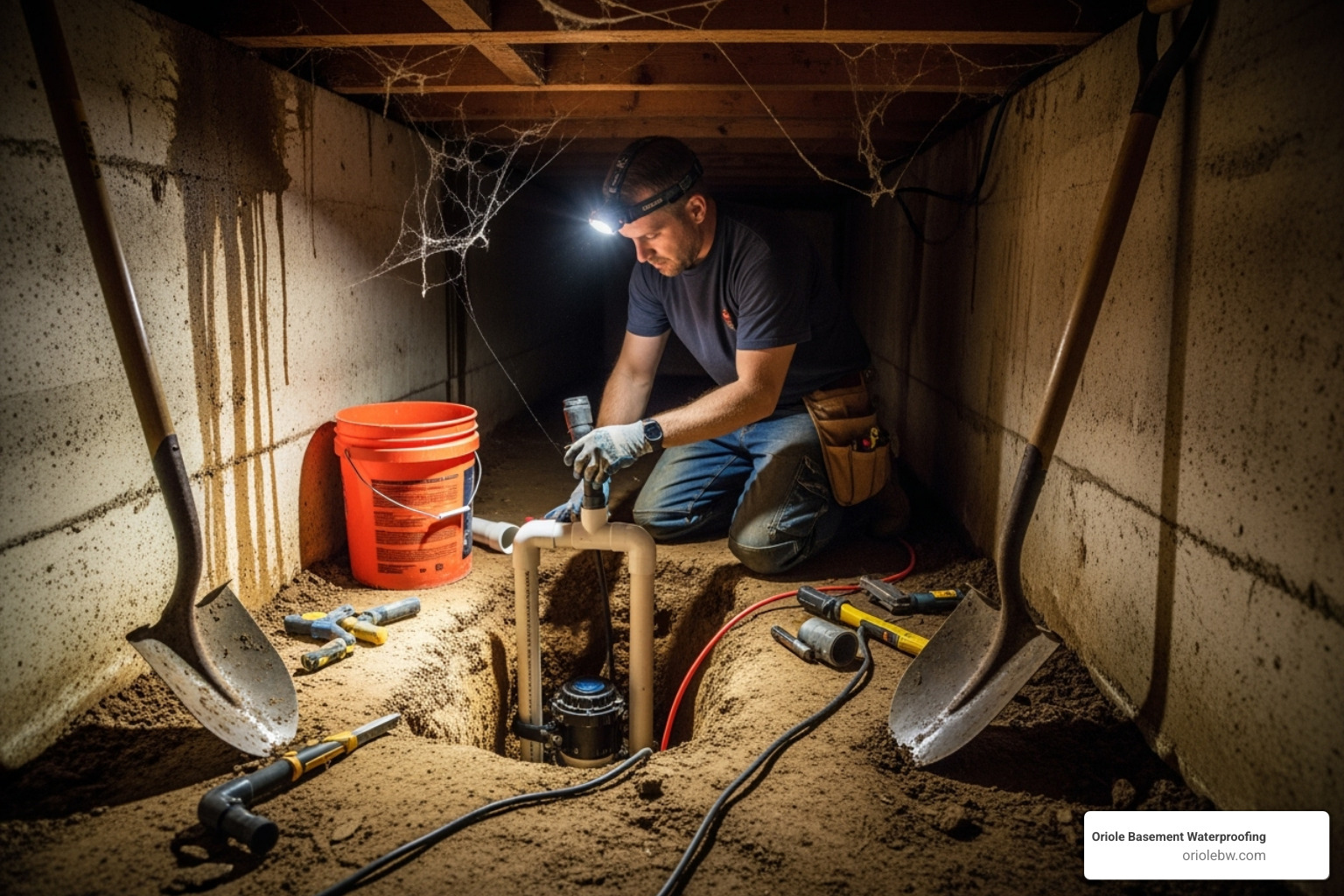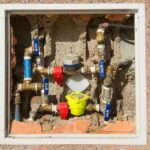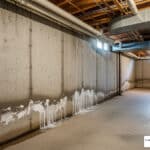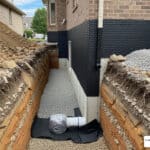What Drives Sump Pump Labor Costs in Maryland and Pennsylvania?
If you’re wondering what is the labor cost to install a sump pump, here’s the straight answer:
Labor costs typically range from $300 to $1,700, depending on complexity:
- Simple replacement: $300-$600 (existing pit, 2-4 hours)
- New installation: $800-$1,700 (includes digging pit, 6-10 hours)
- Complex installations: Up to $4,000 (concrete cutting, drainage work)
- Hourly rates: $45-$200 per hour for experienced professionals
That familiar smell hit me again last week during a home inspection in Towson. You know the one – that damp, musty odor that creeps up from the basement and makes you wonder what’s really going on down there.
The homeowner had been putting off dealing with their failing sump pump for months. “I just need to know what it’s going to cost,” she told me. Sound familiar?
Here in Maryland and Pennsylvania, we deal with everything from sudden summer storms to spring snowmelt. Your sump pump isn’t just a nice-to-have – it’s your basement’s first line of defense against thousands of dollars in water damage.
But when it comes to labor costs, there’s no one-size-fits-all answer. The difference between a simple pump swap and a full installation can be thousands of dollars. The complexity of your specific situation – from your basement’s layout to the type of flooring – determines whether you’re looking at a few hundred dollars or a major investment.
Understanding these cost factors helps you budget properly and avoid sticker shock when you get that quote.

Decoding the Bill: What Goes into Sump Pump Labor Rates?
When homeowners ask me “what is the labor cost to install a sump pump,” I always explain that it’s more than just the hours on the clock. You’re paying for expertise that could save you thousands in water damage down the road.
Professional sump pump installers, whether they’re experienced plumbers or waterproofing specialists like our team, typically charge $45 to $200 per hour. That range might seem wide, but it reflects the specialized skills needed to handle both water and electrical systems safely. We’re not just swapping out a broken appliance; we’re installing your home’s primary defense against flooding.
Here’s what’s actually included in those labor costs: initial inspection and assessment of your unique situation, determining the optimal pump location, evaluating existing drainage, and assessing electrical requirements. Then comes the hands-on work: digging (if needed), connecting plumbing lines, making electrical connections, and thoroughly testing the entire system.
Every step requires precision. I’ve seen too many DIY attempts where the float switch was installed backwards or the discharge line wasn’t properly graded. Those mistakes don’t just waste money; they can lead to basement flooding when you need protection most.
To understand why this work matters so much, it helps to know how a sump pump protects your foundation from hydrostatic pressure and water buildup. This helpful video explains how a sump pump works to keep your basement dry.
A Simple Swap: Labor for a Replacement Pump
Here’s the good news: if you already have a sump pit and your pump just gave up the ghost, you’re looking at the most affordable option. Replacement labor typically runs $300 to $600 and takes our crew about 2 to 4 hours to complete.
Think of it like changing a tire. The infrastructure is already there, so we can focus on getting you back up and running quickly. We’ll remove your old pump, drop in the properly-sized replacement, reconnect all the plumbing and electrical, and make sure everything’s sealed tight.
The beauty of a straightforward replacement is that all the heavy lifting has been done. No concrete cutting, no digging, no running new discharge lines through your basement walls. We can concentrate on what matters most: ensuring your new pump activates reliably and moves water efficiently away from your foundation.
Of course, we never skip the testing phase. We’ll pour water into the pit to verify the float switch triggers properly, check that water discharges where it should, and confirm the check valve prevents backflow. After all, a pump that doesn’t turn on during the next storm isn’t much help.
Starting from Scratch: Labor for a New Installation
Now, if your home doesn’t have a sump system yet, or if the existing setup is completely inadequate, we’re talking about a full new installation with labor costs ranging from $800 to $1,700. Complex situations involving concrete cutting and extensive drainage work can push costs up to $4,000.
Why the jump in price? Because we’re building your entire water management system from scratch. This means digging a new sump pit (often the most labor-intensive part), installing a proper sump basin, running new discharge pipes to carry water safely away from your foundation, and adding dedicated electrical service that meets current codes.
A new installation typically takes our team 6 to 10 hours, but can stretch longer if we hit unexpected challenges. Maybe your basement floor is thicker concrete than expected, or we need to steer around existing utilities. Each home tells its own story, and we adapt our approach accordingly.
The end result, though, is a comprehensive system designed to protect your Maryland or Pennsylvania home for decades. It’s not just about having a pump; it’s about having the right pump in the right location with proper drainage and reliable power.
What is the Labor Cost to Install a Sump Pump? Key Factors That Drive the Price
When homeowners ask us what is the labor cost to install a sump pump, I always tell them the same thing: “It depends on what we find when we get there.” Every basement and crawl space tells its own story, and those stories directly impact your final bill.
After seven decades in the waterproofing business, we’ve learned that three main factors determine your labor costs: how complex the job turns out to be, where exactly we’re working, and what type of system you need. Let me walk you through each one so you know what to expect.

Installation Complexity: The Biggest Cost Driver
Here’s the truth: the floor beneath your feet makes all the difference in your final labor bill. I’ve seen homeowners’ faces drop when they realize their beautiful concrete basement floor is actually working against them cost-wise.
Concrete vs. dirt floors create dramatically different scenarios. If your basement has a dirt or gravel floor, we can dig your sump pit with standard excavation tools. It’s still hard work, but we’re talking about a manageable project that might add $500 to $800 in labor.
But concrete? That’s where things get expensive fast. We need to bring in jackhammers to break through that slab, and trust me, it’s not a quiet process. Your neighbors will know we’re there. Then comes the debris removal, chunks of concrete don’t just disappear on their own. After we install your system, we have to re-pour and finish the concrete to match your existing floor.
This concrete work alone can add $2,000 to $5,000 to your project. It’s not just the time, it’s the specialized equipment, the mess management, and the skilled finishing work to make your floor look like we were never there.
Accessibility challenges throw another wrench into the works. Last month, we worked on a finished basement in Baltimore County where the only access to the ideal sump location was through a narrow utility room packed with HVAC equipment. What should have been a six-hour job stretched to ten hours just because of the tight quarters and careful maneuvering required.
Location, Location, Location: Basement vs. Crawl Space Labor Costs
The physical space where we’re installing your sump pump dramatically affects how long the job takes and, therefore, what you’ll pay in labor.
Basement installations are usually our bread and butter. We can bring in proper equipment, work at a comfortable height, and move efficiently. Most basement installations fall into that $800 to $2,000 labor range we discussed earlier.
Crawl space installations are a different beast entirely. Picture this: our technician lying on his back in a 3-foot-high space, using hand tools because there’s no room for power equipment, taking breaks every 20 minutes because the position is so uncomfortable. What takes two hours in a basement might take six hours in a craml space.
The confined nature of crawl spaces means everything takes longer. Getting materials in and debris out becomes a careful process of passing buckets and tools through small access points. We often have to work in sections, taking frequent breaks, and using smaller, more manual tools.
This increased difficulty can push crawl space installation costs up to $3,900, especially when access is severely limited or drainage work gets complicated. I’ve seen crawl space jobs cost three times more than identical basement installations simply because of the working conditions.
We’ve become specialists in these challenging spaces because we know how critical they are to your home’s health.
What is the labor cost to install a sump pump based on pump type?
The type of sump pump system you choose affects both the complexity and time required for installation. Each pump style brings its own labor considerations.
Submersible pump installations require precision work. These pumps sit directly in the sump pit, completely submerged when water levels rise. Our technicians need to ensure perfect watertight seals, precise basin fitting, and careful connection of both discharge pipes and electrical lines. The extra attention to waterproofing details typically adds 1-2 hours to the installation.
Pedestal pump installations are generally more straightforward from a labor perspective. Since the motor sits above the pit on a pedestal, there’s easier access for connections and future maintenance. However, proper positioning and stability of the pedestal requires careful attention to ensure the long shaft extends correctly into the water.
Combination systems are where labor costs really add up. Many of our customers opt for a primary electric pump paired with a battery backup system, and honestly, it’s a smart choice given how often we lose power during Maryland storms. Installing this combination means essentially doing two installations: the primary pump plus all the additional work for the backup system.
Battery backup installation involves separate electrical work, mounting the battery unit (usually on a wall), running additional wiring, and programming the system to work seamlessly with your primary pump. Even if you’re adding a backup to an existing pump, expect this to add $300 to $600 in additional labor costs.
The peace of mind is worth it, especially in areas like Harford County where storm-related power outages are common.
The Risks of a Weekend Project vs. The Value of a Pro
I’ll be honest with you: I’ve seen what happens when homeowners try to tackle sump pump installations themselves. Just last month, we got a call from a homeowner who had spent his entire weekend “installing” a sump pump. The good news? He saved $800 on labor. The bad news? His basement flooded three weeks later because the discharge line was sending water right back toward his foundation.
We’ve all been there, staring at a YouTube video thinking, “How hard can this really be?” When it comes to something as crucial as protecting your home’s foundation, the answer is: much harder than it looks, with stakes way higher than you might realize.

The electrical hazards alone should give you pause. Sump pumps need dedicated circuits, and improper wiring can lead to dangerous shocks, electrical fires, or damage to your home’s electrical system. I’ve seen DIY installations where homeowners ran extension cords to power their pumps, a recipe for disaster during the very storms when you need your pump most.
Then there’s the discharge line placement. It seems simple enough: pump water out, right? But if that line isn’t properly graded or if it’s too close to your foundation, you’re essentially creating a water feature that feeds right back into your basement. We’ve fixed countless installations where well-meaning homeowners inadvertently made their water problems worse.
Foundation damage from poorly dug pits is another concern we see regularly. Incorrect excavation or insufficient concrete work can compromise your basement floor’s structural integrity, leading to cracks and settlement issues that cost thousands more to repair than the original installation would have cost.
When you choose a professional installation, you’re not just paying for someone to dig a hole and drop in a pump. You’re investing in 70+ years of experience and our lifetime transferable guarantee. We stand behind every installation because we know how to do it right the first time. More importantly, we take a comprehensive look at your entire basement or crawl space to ensure your sump pump works as part of a complete water management system.
What Should Be Included in a Professional’s Quote?
A transparent quote tells you everything you need to know upfront, no surprises, no hidden fees. When we provide a quote for what is the labor cost to install a sump pump, you’ll see exactly where every dollar goes.
Itemized labor costs break down the estimated hours and our hourly rate, including any specialized work like concrete cutting or extensive excavation. Material costs list every component: the specific pump model, basin, piping, check valves, and electrical components we’ll use.
We always specify the pump model and its specifications, the horsepower, gallons per hour capacity, and whether it’s submersible, pedestal, or includes battery backup. Warranty details cover both the manufacturer’s warranty on the equipment and our own lifetime guarantee on the installation work.
Permit fees are clearly outlined when required. Some areas in Maryland and Pennsylvania require permits for sump pump installations, especially when new electrical work is involved. We handle all the paperwork, but you’ll know exactly what these fees are upfront.
Finally, our cleanup process is detailed in every quote. We believe in leaving your home cleaner than we found it, that means proper debris removal and site restoration, not just walking away when the pump is installed.
Why a Waterproofing Pro Sees the Bigger Picture
Here’s what separates us from someone who just installs pumps: we don’t treat symptoms, we solve problems. Water in your basement isn’t just an inconvenience, it’s usually a sign that hydrostatic pressure is building up around your foundation, pushing water inward through any weakness it can find.
A sump pump is absolutely critical, but it works best as part of a comprehensive waterproofing strategy. During our assessment, we’re looking for foundation cracks or signs of structural issues that might be contributing to water intrusion. With our expertise in foundation repair, including carbon fiber straps for bowing walls, sill plate replacement, and floor joist replacement, we can address these underlying issues. If we find a problem that requires a different kind of structural work, like specialized foundation support, we will recommend an assessment from a structural engineer to make sure you get the exact solution your home needs.
Many homes benefit from interior drainage systems, essentially French drains installed along the basement perimeter to collect water before it reaches your floor and direct it to the sump pit. Your pump then efficiently removes this collected water, creating a complete defense system.
This holistic approach is what 70+ years of experience has taught us. True protection comes from understanding how all these systems work together. We want to solve your water problems once and for all, not have you calling us back every few years chasing the same issues.
Frequently Asked Questions about Sump Pump Labor
Over our 70+ years in business, we’ve fielded thousands of questions from homeowners across Maryland and Pennsylvania. These are the ones that come up most often when we’re talking about what is the labor cost to install a sump pump.
How long does a professional sump pump installation take?
“How long will you be here?” That’s usually the first question we hear when we arrive for an installation. The honest answer is: it depends on what we’re working with.
If we’re doing a simple replacement where you already have a sump pit and everything’s accessible, we can typically wrap things up in two to four hours. It’s like swapping out a water heater, the infrastructure is there, so we’re mainly focused on getting the new unit connected properly and testing everything thoroughly.
But when we’re starting from scratch with a new installation, you’re looking at a much longer day. Plan on six to ten hours for a complete new system. This includes digging the pit, setting the basin, running discharge lines, and making all the electrical connections.
Now, here’s where things can get interesting. If we need to break through concrete flooring, that timeline can stretch significantly. Jackhammering is tough work, and then there’s the cleanup and concrete patching afterward. The good news? Once we pour the new concrete around your pit, your pump is ready to work immediately, you don’t have to wait for the concrete to cure before the system protects your home.
Are there extra labor costs to install a battery backup?
Absolutely, and here’s why it’s worth every penny. Installing a battery backup system isn’t just plugging in another device, it’s essentially adding a second layer of protection that requires its own dedicated installation work.
The battery backup needs separate wiring from your electrical panel, and it has to be mounted securely in a dry location near your sump pit. Our technicians will also run additional connections between the backup unit and your primary pump. It’s detailed electrical work that takes time to do safely.
But here’s the part that really matters: we thoroughly test the backup system before we leave. We’ll actually simulate a power outage to make sure the battery kicks in seamlessly. During one installation in Baltimore County last month, we finded the homeowner’s electrical setup needed a small adjustment for the backup to work properly. If we hadn’t tested it, they would have found out during the next storm, which is not exactly ideal timing.
Will a new sump pump increase my home’s value?
This is a great question, especially from homeowners thinking about selling. A professionally installed sump pump might not have the flashy appeal of a kitchen renovation, but it absolutely adds value to your home, particularly here in Maryland and Pennsylvania where basements are so common.
Buyer peace of mind is huge. When potential buyers see a quality sump pump system during a home inspection, they know they’re not inheriting a water problem. We’ve had real estate agents specifically mention our installations as selling points during showings.
More importantly, a sump pump protects your existing investment. One flooded basement can cost tens of thousands in repairs, not to mention the headache of dealing with mold and structural damage. By preventing these problems, your sump pump maintains your home’s value over time.
In flood-prone areas or homes with high water tables, a sump pump isn’t just a nice feature, it’s essential infrastructure. We’ve seen homes in certain neighborhoods become nearly unsellable without proper water management systems. Your sump pump protects the very foundation your home sits on, and that foundation protection directly impacts your property’s long-term value and marketability.
Your Foundation’s First Line of Defense
That homeowner in Towson I mentioned earlier? She called me three months after we installed her new sump pump system. “Best money I ever spent,” she said. “We had that massive storm last week, and my basement stayed bone dry while my neighbor was dealing with two inches of water.”
That’s the thing about what is the labor cost to install a sump pump: it’s not really about the upfront expense. It’s about what you’re buying: peace of mind, protection for your biggest investment, and the confidence that comes from knowing your home is ready for whatever Maryland weather throws at it.
Yes, the labor costs can range from $300 for a simple replacement to $4,000 for complex installations involving concrete work or challenging crawl spaces. But when you break it down, you’re not just paying for someone to put a pump in a hole. You’re investing in 70+ years of experience, in professionals who understand how water moves around Maryland foundations, and in a lifetime transferable guarantee that protects your investment long after we’ve finished the job.
We’ve seen too many DIY disasters and quick-fix attempts that end up costing homeowners thousands more in water damage repairs. When you choose Oriole Basement Waterproofing, you’re getting the expertise that comes from protecting Maryland and Pennsylvania homes since the 1950s. We don’t just install sump pumps; we create comprehensive water management systems that address the root causes of basement moisture.
Your foundation deserves more than a weekend project or a bargain-basement installation. It deserves the kind of professional attention that keeps your basement dry for decades, not just seasons. That’s what we’ve been delivering to families across our region for over seven decades, and it’s what we’ll deliver to yours.
Ready to protect your home the right way? We’re here to help, just like we’ve helped thousands of your neighbors create strong, dry, healthy basements they can count on.
Protect Your Baltimore Home with a Reliable Sump Pump System






